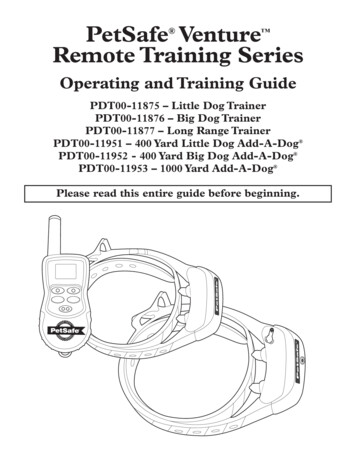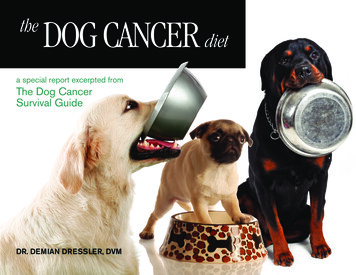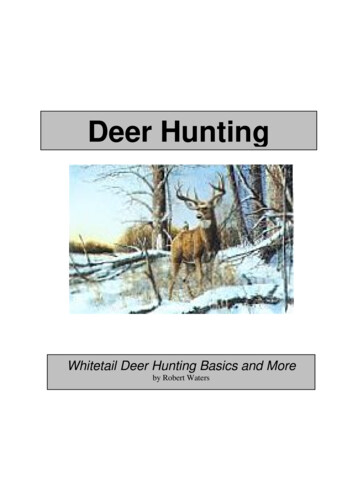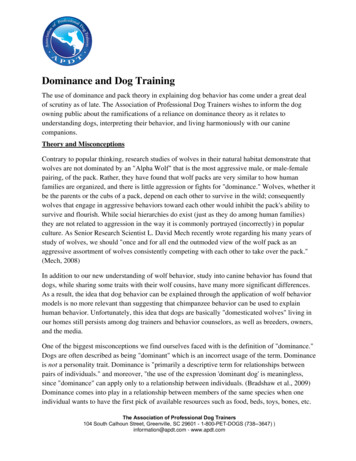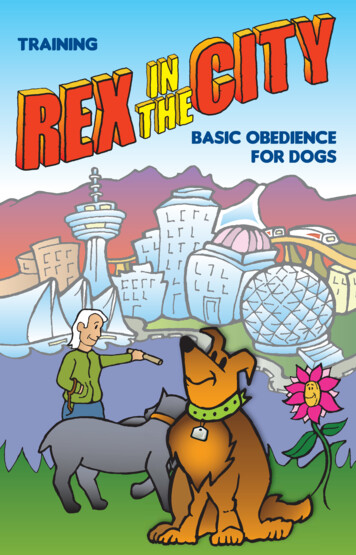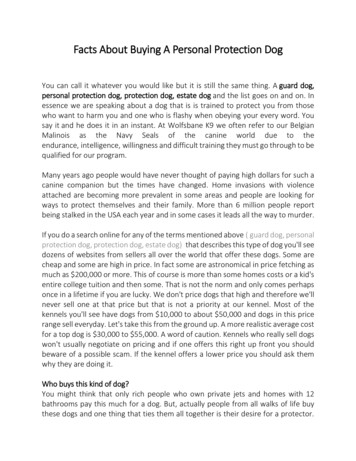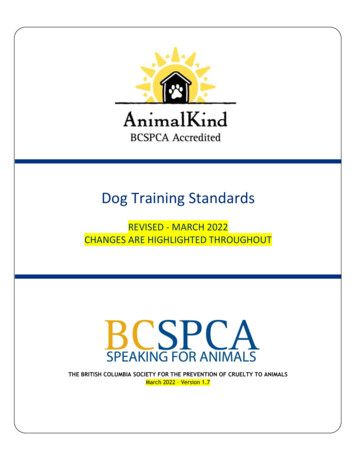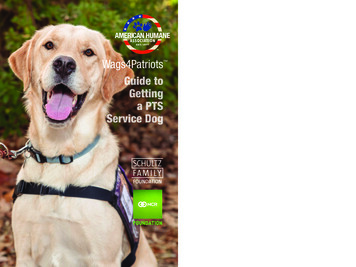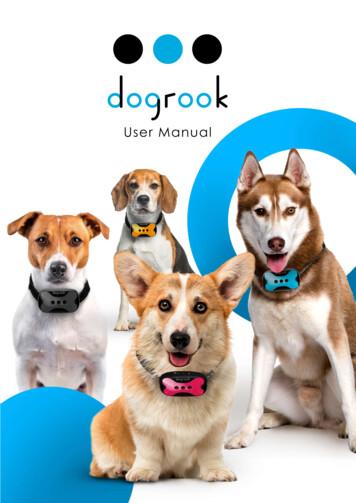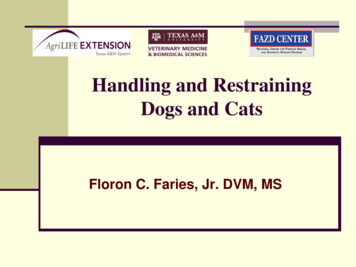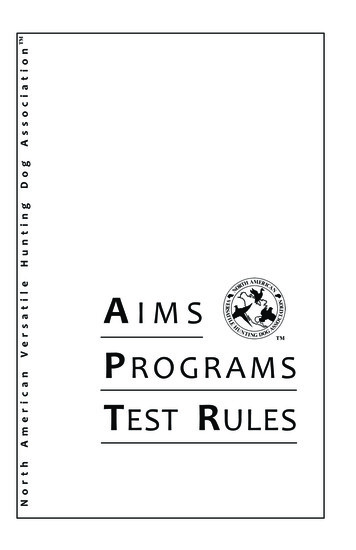
Transcription
N o r t hA m e r i c a nVe r s a t i l eAIMSPROGRAMST EST R ULESTMH u n t i n gD o gA s s o c i a t i o nTM
NAVHDATMAIMS PROGRAMS TEST RULESA publication of the North American Versatile Hunting Dog AssociationRevised August 2018United States Copyright 2001Canadian Registration #258108Printed in the USANAVHDA International has registered trademarks/service marks associated with the NAVHDA logoand the acronym NAVHDA as well as common law rights associated with these marks.NAVHDA Information & ServicesProgramsHandler ClinicsApprentice JudgingNAVHDA TestsNAVHDA RegistryDog RegistrationLitter RegistrationKennel RegistrationTest Information ServiceTest ReportsDog ReportsBreeder ReportsMembership ServicesChapter MembershipInternational MagazineBreeder Support ProgramsYouth Programs International Brochures International Membership ApplicationFor information on these programs and servicesvisit us on the Web atwww.navhda.orgor contact us at:NAVHDAP.O. Box 520Arlington Hts, IL 60006-0520Email: navoffice@navhda.orgTel: 847/253-6488Fax: 847/255-5987
iForewordThe specific and primary purposes for which this corporation is formed are:1. To educate all interested persons in the techniques of training versatilehunting dogs, to conduct tests of versatile hunting dog breeds in NorthAmerica and maintain records of such tests for all interested persons,and to promote selective breeding and population control of versatilehunting dog breeds.2. To prevent cruelty to animals by the use of properly trained hunting dogs.3. No substantial part of the activities of this corporation shall consist ofcarrying on propaganda, or otherwise attempting to influence legislation,and the corporation shall not intervene in any political campaign.4. The corporation shall not discriminate on the basis of race, color, creed,national origin, sex, religion, or any legally proscribed classification, inits programs, activities, or employment practices.The primary purpose of this booklet is to provide a reference guide forowners, handlers and judges of versatile hunting dogs in preparing for andparticipating in North American Versatile Hunting Dog Association tests. Ofparticular interest in this respect are the discussions of test standards whichconstitute the basis for evaluating dog performance. This booklet also providesguidelines for local chapters of NAVHDA in developing plans and selectinglocations appropriate for NAVHDA tests and other activities.This booklet also covers the aims, philosophies and programs of the NorthAmerican Versatile Hunting Dog Association. It includes a brief introductionto the various versatile breeds and a summarized history of the versatilehunting dog.Finally, as a salute to the very best of hunting companions, this booklet isdedicated to versatile hunting dogs everywhere. May they all enjoy manysuccessful days afield with good masters. The Editors
iiContentsForewordIntroductionThe Versatile BreedsThe NAVHDA Dog RegistryKennel RegistrationTest Information ServiceChapter 1Chapter 2Chapter 3Chapter 4Chapter 5The Versatile Hunting DogDefinitionsEarly HistoryThe Versatile Breeds in North AmericaThe Versatile Hunting Dog in PerspectiveImproving the Versatile BreedsIntroduction to NAVHDA TestsTest CriteriaHandling of Game BirdsTypes of TestsEligibilityPrize Classifications and AwardsScoring SystemJudges and JudgingProspective JudgesSafetyApprentice JudgesPublication of Test ResultsSportsmanshipCommon Areas of EvaluationApplicationUse of NoseSearchPointingDesire to WorkCooperationPhysical AttributesThe Natural Ability TestImportancePreparing for the TestOrganization and ScopeField PhaseTracking PhaseScoring SystemWater PhaseJudges’ ScorecardJudgment of Physical CharacteristicsThe Utility Preparatory TestPurpose and ScopeWater GroupWater SearchWalking at HeelSteadiness by BlindRetrieve of DuckField GroupField SearchPointingSteadinessRetrieve of Shot BirdRetrieve by 141515161617171717181818
iiiScoring SystemJudged ThroughoutJudges’ ScorecardPhysical AttributesUse of NoseDesire to WorkCooperationObedienceChapter 6The Utility TestPurpose and ScopeThe Water GroupSearch for a DuckWalking at HeelRemaining by BlindSteadiness by BlindRetrieve of DuckJudgment of Physical AttributesThe Field GroupSearchPointingSteadiness on GameRetrieve of Shot BirdRetrieve of Dragged GameJudged ThroughoutUse of NoseDesire to WorkStaminaScoring SystemCooperationJudges’ ScorecardObedienceChapter 7The Invitational TestPurpose and ScopeInvitational RulesField WorkWater WorkDouble MarkHeelBlind RetrieveHonoring at BlindScoring SystemJudges’ ScorecardsChapter 8Chapter 9Chapter 10AppendixTraining AssistanceThe Rewards of TrainingChapter Training SessionsNAVHDA Handler ClinicsMethod and Scope of InstructionPurposePhysical 2728282829293031313132323233333438383939The Judges’ RoleEyesTeeth404040NAVHDA Sanctioned Test Capacity Chart42
ivIntroductionThe North American VersatileHunting Dog Association(NAVHDA) is a legally recognizednon-profit organization dedicatedto fostering, improving, promoting,and protecting the versatile huntingdog in North America.Underlying these aims is thedesire to serve the interests ofgame conservation, the preventionof cruelty to animals, and goodsportsmanship by encouraginghunters to use dogs that are welltrained in work before and after theshot, on land and in the water. Tothis end, many of the discussions inthis book are framed in the contextof a hunting situation. Experienceas a hunter, while not essential,is highly desirable and will aid inunderstanding many of the rulesand guidelines discussed here.It is not the intent of NAVHDA todilute or replace any other systemof evaluating the performance ofhunting dogs, nor does NAVHDAdesire to interfere in any way withthe prerogatives and activities ofany breed club. Rather, NAVHDAis meant to supplement theactivities of the several versatilebreed clubs by providing a proven,standard method of evaluatingthe performance of all versatilehunting dogs, regardless of breed.NAVHDA operates under bylaws approved by the membership.These by-laws provide forofficers elected by popularvote who, together with certainappointed officials, constitute anExecutive Council charged withfurnishing direction and guidanceto NAVHDA programs. Mostsanctioned NAVHDA activities inthe field are sponsored by similarlyThe Versatile BreedsThere are several breeds of versatiledogs common in continental Europe,and with four exceptions, all weredeveloped during the last decades ofthe 19th century. The four exceptionsare much older breeds that provideda base for some of the others. Theseare the Weimaraner, the Vizsla, theBrittany, and its German cousin, theSmall Munsterlander.The tracking hound, pointer andwaterpudel were the basic breedingstocks most widely used to developthe short and wirehaired groups. Thelonghaired group evolved from the SmallMunsterlander and flat-coated retriever.Currently NAVHDA recognizes and maintains studbooks for the following PSHSMSPSTVIWMGRWVBlue Picardy SpanielBracco ItalianoBraque D’auvergneBraque Du BourbonnaisBraque FrancaisBrittanyCesky FousekDrentsche PatrijshondEnglish SetterFrench SpanielGerman Longhaired PointerGerman Shorthaired PointerGerman Wirehaired PointerGordon SetterIrish Red & White SetterIrish SetterLarge MunsterlanderPerdiguero DeburgosPicardy SpanielPointerPortuguese PointerPudelpointerSlovakian Wirehaired PointerSmall ehaired Pointing GriffonWirehaired Vizsla
vorganized local chapters of NAVHDA. Each local chapter is composed of menand women who represent a cross section of supporters of a number of the variousversatile breeds.Although sanctioned tests for versatile hunting dogs represent the backbone of theNAVHDA program, other complementary and supporting activities are conducted.Included are training clinics, Handler Clinics, Judge’s Workshops, and a monthlymagazine.The NAVHDA Dog RegistryThe registration of all tested dogs allows NAVHDA to provide vital test results tobreeders and prospective buyers. These test results are available by dog, sire or damand are also listed for all generations on the pedigree.Each dog registered with NAVHDA receives a certified three generation pedigreeshowing test results, color of dogs and hip dysplasia certification of parents and grandparents where available.Kennel RegistrationA record of protected kennel names for NAVHDA members is maintained by theRegistrar.Test Information ServiceThe test information service maintains a record of test scores for all NAVHDA testeddogs. This information is valuable for selective breeding, using dogs with provenability for breeding, and to assist in puppy selection. Detailed reports on individualdogs, sires and dams are available to members or interested persons on the NAVHDAwebsite. See Foreword for further information.
11The Versatile Hunting DogDefinitionsWithin the context of the NAVHDA philosophy, the description “versatile huntingdog” is a generic term applied to a dog that is bred and trained to dependably hunt andpoint game, to retrieve on both land and water, and to track wounded game on bothland and water.The versatile breeds, as we know them today, are products of Europe. Nodistinctive breed of versatile dog has been developed in North America. For this reason, breeds with versatile hunting characteristics are sometimes loosely referred to asthe “Continental Breeds.”Early HistoryIn feudal times, hunting was the exclusive privilege of wealthy landowners. They helda monopoly on hunting for centuries and created a very cultivated sport, completewith strict dictates and customs. Their reputations and wealth demanded the very highest standards in everything associated with the hunt.Each type of game called for dogs developed for the particular game. Large kennelswere maintained with large staffs to handle and train the dogs. Many specializedhunting breeds still used today owe their existence to these men and times. The Industrial Revolution changed all this. New classes evolved in society. A greatly elevatedstandard of living created interest in many pursuits which before were restricted to thelanded gentry. Hunting was one such pursuit.Intense interest and the pressure of new wealth gave rise to new hunting laws whichmade the sport available to a much broader element of the populace. Most of thesenew hunters came from the middle classes - doctors, lawyers, judges, teachers, and allvarieties of merchants and businessmen. They lived in cities and towns and had neitherthe space nor the time to maintain large kennels of specialized hunting dogs. The pointer,among others, has been recognized for over 400 years as a superb hunting dog, but duringmost of this period has been used as a pure field specialist. These dogs were superior fieldspecialists, but they were difficult to train and handle for anything but field work.As hunting increased in popularity in the latter half of the 19th century, the need fora dog with more versatile characteristics became increasingly apparent. Using theexisting breeds of hunting dogs, dedicated men set out to produce the various versatile breeds. Most of the breeds were produced in approximately the same time frame.There were some differences in physical characteristics, but the hunting characteristicswere closely allied.What were the breeders trying to develop? They wanted breeds that wouldhandle a variety of game, both feather and fur, before and after the shot. A dog has topossess a keen nose and strong pointing instinct, a lively temperament, eagerness toretrieve from both land and water, stamina, and a durable coat and hide that would nothamper his work in cold water and heavy brush. The dogs also had to be intelligent,relatively easy to train and have a character compatible with protecting, and living inor at their masters’ dwellings.Many breeders kept good records of their programs, but others did not.Pedigrees, as we know them, were unheard of in those days. Practical breeding experience, patience, and finally, a better understanding of genetic laws,established pure breeds.
2These pioneering efforts have paid off handsomely for the European hunter.Standards are high and the dogs perform superbly in their native lands. The reasonfor this is quite evident. In Europe, versatile breeds receive support from enthusiastic clubs, dedicated to the improvement of the breeds. True versatile tests coverevery aspect of the dogs’ ability, and only dogs with proven ability are used inbreeding programs.The Versatile Breeds in North AmericaNo significant influx of the versatile breeds occurred in North America until wellinto the 20th century. Some breeds did not arrive until after World War II. Thesituation facing these new arrivals was less than favorable. On a continent wherehunters were traditionally wed to the concept of the “specialist, or one-purposedog, there were few people with the knowledge, insight, and understanding necessary to place the versatile dog in proper perspective and thus make full use of itsinherent potential.Prior to the formation of NAVHDA in 1969, there were few strong versatile gundog clubs. Tests tailored for versatile breeds were rare. If the owner sought somecomparative measure of the usefulness of his dog, he had little choice but to compete against the pure specialist and under the other fellow’s rules. There was nostandard rule book for judging of versatile hunting dogs, and there were little or nowritten materials available on training and handling these fine gun dogs.The examples of dedication and hard work set by NAVHDA members during theformative years continue to be followed. As a result, since 1969, a substantial number of proven versatile gun dogs have been developed, and the number is growingat a healthy rate. However, much work remains to be done in the fields of publicunderstanding and continued improvement of the versatile breeds in North America.The Versatile Hunting Dog in PerspectiveFundamental to any program to improve the versatile breeds is the requirement toput into perspective the role played by the versatile dogs in the North Americanhunting scene.It must be understood that the versatile dog was not developed to replace orimprove upon any other hunting breed. Rather, it was developed to provide theon-foot hunter who, for one reason or another, chooses not to maintain a kennel ofspecialists, with a dog that will serve as a dependable hunting companion in thepursuit of a variety of game in a variety of environments.Constructive dialogue between hunting dog enthusiasts, regardless of personal preferences, is healthy. However, we must not lose sight of the fact that versatile hunting dogsas a group are bred and trained for essentially different purposes than those comprisingthe several groups of “specialty” hunting dogs. It follows that systems of evaluating performance will differ between groups, with the proponents of each group using a systemdeemed best suited for determining the ability of dogs within that group to perform thetasks for which they were bred and trained.It is the privilege of any owner to enter his dog in any test or competition for which thedog is eligible. He should shed no tears at the result, if the rules and standards are nothis dog’s “cup of tea.” This is not to say that some unique specimens within any groupcannot enter the arena of another and turn in a creditable performance.No useful purpose is served by comparing the performance of one school ofhunting dogs against the rules and standards of another. Such comparisons make
3about as much sense as comparing the performance of a good football quarterbackagainst that of a good baseball pitcher. It is the NAVHDA position that such comparison should be discouraged.Improving the Versatile Breeds“Breed the best to the best” is a time-honored and proven axiom among animal breeders whether they be dog fanciers, horsemen, cattlemen or whatever.In the case of the North American versatile hunting dog, just as it is in Europe,comprehensive tests that truly consider versatility in the field are the foundation upon which we must build. Only dogs of proven ability should be used inbreeding programs.In practice, this requires cooperation and a shared sense of responsibility betweenbuyers and breeders, whether the latter be full-time professionals or occasionalbreeders. The breeder should be extremely selective and use only dogs of provenability as breeding stock. Buyers should cooperate by seeing to it that the new dogsare prepared, and exposed to, true tests of versatility during appropriate stages of theirdevelopment. The optimum is to test every dog in every litter. It is only through thisspirit of cooperation and shared responsibility that continuing improvement can bemade. Unscrupulous and irresponsible breeders, who place other considerations aheadof improving the breeds, can be exposed for what they are.2Introduction to NAVHDA TestsTest CriteriaTo be truly meaningful, tests for versatile hunting dogs must meet certain criteria.They must be conducted in an environment that reflects actual hunting conditions andsituations. They must test all characteristics required of a good versatile dog. Judgesmust be knowledgeable, consistent, and objective. Accurate and complete records oftest performance must be kept on each dog tested. All testing and evaluation are to bewithin the context of judging dogs as useful, productive hunting companions. NAVHDA tests have been designed with these requirements in mind.Handling of Game BirdsThe testing of versatile hunting dogs requires the use of pen raised game birdsthroughout all levels of NAVHDA’s testing program. Local chapters are held to thehighest level in the ethical treatment and care of all game. All game birds are expectedto replicate, as nearly as possible, those in the wild and receive proper care at all timesto ensure they are fresh and healthy.When returning from the field, gunners are expected to see that retrieved birds areproperly cared for and not left in view of the gallery.Chapters are evaluated on the quality of game birds they supply for their tests, bothdead and alive. Quality dead birds are equally important to lend consistency and fairness to all tests. Dead birds required for UPT, UT and Invitational Tests should not bedispatched more than 12 hours prior to each testing day. Ideally, these birds should be
4dispatched early on the morning of each test day and kept cool and dry throughout theday. Dead birds cannot be used for more than one day of testing and at no time willpreviously frozen birds be used.Types of TestsEligibility Only NAVHDA registered dogs areeligible to participate in NAVHDA tests.NAVHDA tests are open to eligible dogsfrom the International publication dateof the test announcement. All owners and handlers of dogsentered in a NAVHDA test must beNAVHDA International members. Dogs are eligible for a Natural Ability Testup until, and including, the day they reach16 months of age. Dogs over 16 monthsmay be run for evaluation only. Dogsover 16 months may only be run if spaceis available. No prize classification can beawarded the dog run for evaluation. There are no age restrictions on dogsentered in the Utility Preparatory Test,Utility Test or the Invitational Test. Onlyinvited dogs are eligible to participate inthe Invitational Test. No restrictions are placed on thenumber of times a dog may be tested,provided eligibility requirements aremet. Repeated tests are encouragedthroughout the dog’s development. Dogs run in the Invitational Test musthave DNA on file with NAVHDA or DNAapplied for, through NAVHDA, prior tothe closing date of entry and the primaryowner and handler of each entry mustbe a NAVHDA International member. Bitches “in season” may be run inNAVHDA tests. These dogs will be runlast at each phase of testing. (Note: “Inseason” bitches will be run last at eachphase of testing, on the last day of Invitational testing.)NAVHDA conducts four levels oftests. As the description implies, theNatural Ability Test is designed toevaluate young dogs on their inherent natural abilities with a view togaining an insight into their possiblefuture value as versatile gun dogs (seeNA Chapter). The Utility Preparatory Test is designed to evaluate thedog midway in its training towardsbecoming a reliable versatile gundog (see UPT Chapter). The UtilityTest is designated for more experienced dogs in an advanced state oftraining. It evaluates their ability toperform as reliable versatile gun dogsand demonstrates their physical andmental capability to take training (seeUT Chapter). The Invitational Test isthe flagship of NAVHDA tests. Onlythose exceptional animals that havedemonstrated superior skill and obedience in Utility Tests are eligible toparticipate (see Invitational Chapter).Prize Classifications and AwardsIn NAVHDA, the words “prize” or“pass” do not relate to placementas in a race or competition. Dogsare evaluated against an establishedstandard rather than each other. Prizesare awarded on the basis of numerical scores achieved in the test. Eachdog that meets or exceeds minimumstandards is placed in one of threecategories, i.e., Prize I, II, or III, withPrize I being the highest. Severaldogs being tested at the same timemight be awarded the same prizeclassification.Each dog qualifying for a prize is eligible for a simple, standardized plaqueengraved with essential information,such as name, date, type test, etc. Theonly thing that distinguishes a Prize
5I plaque from a Prize III plaque is the score and prize classification inscribedthereon. Any other award or trophy, including cash awards, is specifically forbidden.Dogs achieving a passing score in the NAVHDA Invitational are awarded thetitle of “Versatile Champion.”Scoring SystemThroughout this booklet, the word “test” is used instead of the word “trial.” Thereason for this is that under the NAVHDA system, each dog’s performance ismeasured against a definitive standard rather than against the performance of other dogs being tested. All NAVHDA tests are scored on a point-index system. Eachtask that the dog must perform and each category on which it is scored during thetest is allotted a fixed index number which indicates its relative importance. Thedog’s performance in each part of the test is given an achievement score based ona scale of Zero (Failure) to 4 (Excellent).The fixed index number is multiplied by the achievement score to arrive at thescore attained in that part of the test. For example: The fixed index number assigned the search phase is 5. Assume that the Judges’ consensus for this phase ofthe test awards the dog a performance score of 3 on the zero to 4 scale. The dog’sscore for the search phase thus becomes 15 (5 x 3 15).The sum total of the scores determines the placement of the dog in a first, second, or third prize classification, provided it has earned the minimal acceptablescores required in each part of the test. Every dog entered in a test is permittedto complete the entire test, even though it might have failed at some point duringthe test. The above scoring system is illustrated in detail for NA in Chapter 4, p.13, UPT in Chapter 5, p. 18, UT in Chapter 6, p. 28 and INV Chapter 7, p. 33.A Judge will record the test results on NAVHDA pedigrees presented at theconclusion of a test. The detailed score of each dog tested is made a matter ofpermanent record. These records are available from the NAVHDA Test Information Service. Printouts of test information are available by breed, sire, dam andprogeny. NAVHDA encourages breeders and buyers to avail themselves of thisservice when considering breeding or purchasing a dog.Judges and JudgingNAVHDA realizes that careless or biased judging would not only be unfair to thedogs but would also defeat any attempts by NAVHDA to improve the versatilehunting breeds. The length of timeavailable to a Judge to observe an indiRequirementsvidual dog during a test is relativelyA person desiring to become an approvedlimited and only a thoroughly compeNAVHDA Apprentice Judge must:tent Judge can assimilate all the manyfacets of the dog’s performance and Be at least 18 years old.express a fair and accurate opinion. Meet the requirements for becomingFor these reasons, NAVHDA exercisesan Apprentice Judge in accordance withgreat care in the training and seleccurrent policy.tion of its Judges. They are selectedfrom among experienced hunters who Make application to the Director ofpossess character and integrity andJudge Development to become anhave also trained and handled versaApproved Apprentice.tile hunting dogs. In a further effort to
6Prospective Judges Must: Successfully complete the Apprentice Judge program. Qualify a dog he/she has trained,in a Utility or Invitational Test inaccordance with current policy. Make application to the Director ofJudge Development in accordancewith current policy. Be approved by the NAVHDAExecutive Council.Judges Are Required To: Qualify a dog he/she has trained andhandled in a NA, UPT, UT or Invitational Test within the previous threeyears. Further, each judge is requiredto qualify a dog he/she has trained andhandled in a UPT, UT or InvitationalTest within the previous six years. Attend a NAVHDA Judges Workshopevery third year. All NAVHDA judges are reviewed bythe Executive Council annually andqualified persons are reappointed forthe following year.achieve fairness and objectivity, it isrequired that each NAVHDA sanctioned test be judged by three Judges.In the case of a last minute illness oremergency, two Judges may be used,but only when all possible meansof finding a replacement have beenexhausted.One of the three Judges will be designated as the Senior Judge. The SeniorJudge acts as team captain and rules onprocedural matters. The Senior Judge,in consultation with the judging team,has the responsibility to assure the test isconducted according to NAVHDA rules.In an extreme case, where adverse conditions exist which can not be corrected,the judging team may cancel the test.At least one of the three Judges mustbe from outside the sponsoring chapteror club. NAVHDA judges serve withoutpay or honorariums, but are reimbursedfor all expenses.Judges are not allowed to test dogs onthe day they are judging. A Judge maynot judge a dog that he or she or anymember of his or her family owns, orhas any ownership interest. In addition,a Judge may not judge a dog handledby any member of his or her family(“member of the family” is defined asSafety Hinged frame (break-open) shotguns of conventional gauge will be used in NAVHDAtests. Autoloaders and pump action guns are strictly forbidden, whether loadedwith blank ammunition or not. All guns will be carried in the open position until justbefore the shot. When blank ammunition is called for, it must be 12 gauge, professional factorymanufactured, smokeless powder, blank ammunition (field trial poppers). Field marshals will ensure that the gallery remains at a safe distance in a position awayfrom the line of fire. All persons in the field, while live ammunition is being used, mustwear one or a combination of the following blaze orange garments: hat, vest or jacket. Individuals may accompany the handler, the gunners, and the Judges in the field duringa test with prior permission of the Senior Judge after consultation with the handler. Loose and unattended dogs are prohibited.
7spouse, sibling, parent, child, whether natural or adopted or anyone married to or in arelationship with a member of the judge’s family.). A judge may not at any time duringa test be a part of a judging team that judges his/her own dog(s) or dog(s) owned orhandled by his/ her family members or any member(s) of the same household. Thisincludes stepping out for a particular handler/dog team and then stepping back in forthe remaining dogs. Spouses and domestic partners may not judge together on thesame judging team.Apprentice JudgesApprentice Judges work in the field under the tutelage and supervision of the test’sJudges and specifically the Senior Judge. The evaluations made by Apprentice Judgesare not considered in determining the official scores of dogs being tested. They are,however, used in evaluating the accuracy of the Apprentice Judge. This system is usedto increase the Apprentice’s experience and knowledge.At the end of the test, all Judges provide an evaluation of the Apprentice Judges’ performance to the Director of Judge Development. All rules and restrictions that applyto NAVHDA Judges also apply to Apprentice Judges.Publication of Test ResultsSomewhat unique in dog tests or trials is the NAVHDA practice of announcingscores. It is our belief that an owner, who shows the necessary interest and is willing to spend the time and money involved in testing a dog, has the right to knowexactly how the dog was evaluated and why.With this in mind, NAVHDA provides that at the end of each testing day, the judgingteam will publicly read the detailed scores of each dog tested. Further, the judgingteam makes itself available to discuss the scores awarded with a view to assisting theowner in further development of the dog.The owner will be sent a copy of the official score sheet from NAVHDA.SportsmanshipIt is expected that all persons involved in conducting, participating in, or observing aNAVHDA test will adhere to accepted principles of good sportsmanship. No hard andfast rules are considered necessary among ladies and gentlemen, but as an example,a handler who loses his head and administers cruel and unnecessary punishment to adog in the field will be excused with no refund. The dog, however, may be permittedto complete the course under a different handler.3 Common Areas of EvaluationApplicationThe areas of evaluation discuss
To educate all interested persons in the techniques of training versatile hunting dogs, to conduct tests of versatile hunting dog breeds in North America and maintain records of such tests for al
